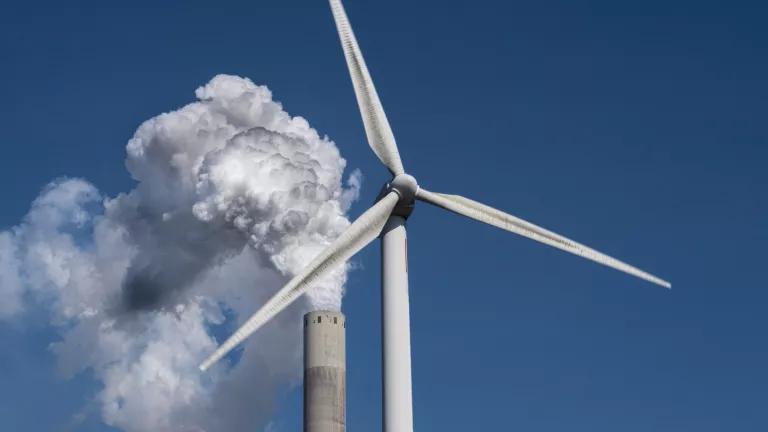Man-Bites-Dog Story: Power Companies Support EPA Regulation
Odd as it may seem, in the Supreme Court's latest climate case, the power industry is overwhelming on EPA’s side.

Electric power companies support EPA regulation of their industry’s carbon pollution. That’s the message—surprising to some observers—in briefs filed in West Virginia v. EPA, the coal companies’ and red states’ challenge to EPA’s Clean Air Act authority now pending before the Supreme Court.
Nine power companies serving 40 million people nationwide filed a brief supporting the lower court decision in American Lung Association v. EPA, setting aside the Trump EPA’s repeal of the 2015 Clean Power Plan and the do-nothing replacement called the Affordable Clean Energy rule issued in 2019. The Edison Electric Institute, representing all investor-owned electric companies, submitted a friend of the court brief supporting EPA’s authority. So did 14 former high-ranking power company executives, four experts on the nation’s power grid, and eight former commissioners of the Federal Energy Regulatory Commission.
It’s worth emphasizing: Not a single power company petitioned for Supreme Court review. (Several rural cooperatives filed briefs on the coal industry’s side, but none saw fit to bring its own petition.) Odd as it may seem, the power industry is overwhelming on EPA’s side.
Their views may matter a lot when the Supreme Court hears oral arguments on February 28th. In fact, the Court has chosen to hear from the power companies, in addition to the government. (In the recent case on vaccine mandates for health care workers, Justice Kavanaugh noted the “unusual” situation that “the people who are regulated are not here complaining about the regulation.”)
So what are the power companies, their association, and the experts saying?
Power Companies
Together with states and environmental and health groups, the nine power companies prevailed in the D.C. Circuit Court of Appeals, which ruled against the Trump-era argument that the Clean Air Act requires a strictly inside-the-fence approach to setting power plant carbon pollution standards, with no room at all for tried-and-true regulatory tools such as averaging or trading.
In their Supreme Court brief, the power companies argue that the case presents no “major question” because no regulation is now in effect, courts cannot review hypothetical future rules, and EPA is acting squarely within its designated role when regulating power plant pollution. The lower court reviewed the Clean Power Plan repeal, not the original CPP (whose 2030 emission reduction goals were already met by 2019 through market forces). Apart from holding that the agency’s interpretation erroneously limited EPA’s authority, the court did not “ratify any expansive agency authority to make decisions of vast economic and political significance.” What EPA might do in the future could be reviewed then, but not now.
The “best system of emission reduction” (BSER), the power companies write, should reflect how the power sector actually works. Power companies routinely ramp various plants’ generation up and down to produce the amount of electricity needed by the grid minute by minute in the lowest-cost way. And companies routinely use tools like emissions averaging and trading to meet environmental limits as efficiently as possible, so that those tools were “adequately demonstrated” and reflect the statutory requirement to “take into account cost.” The statutory language, they write, does not hem EPA in to only “measures applied ‘at and to’ an individual plant,” as the Trump administration claimed, and “does not limit the means that can be considered in determining BSER or that can be used by States and power plants to meet the standard of performance set by the States."
Edison Electric Institute
Even more eye-opening is the brief for the trade association representing all investor-owned power companies (and joined by the association representing the nation’s clean water agencies). EEI focuses on the Court’s 2011 decision in American Electric Power v. Connecticut, which found that Section 111 of the Clean Air Act “speaks directly” by authorizing EPA to curb CO2 emissions from both new and existing power plants and by instructing the agency to determine “whether and how” to regulate those emissions. This statutory authority, the Court held, displaces the pre-existing federal common law of interstate air pollution, under which states and others had sued the largest power companies. The EEI brief cautions that eliminating EPA’s authority would expose power companies to federal common law suits again. “While it may seem counterintuitive that the Nation’s investor-owned electric companies, in particular, should favor EPA regulatory authority, the alternative could be the chaotic world of regulation by injunctive fiat.” To be sure, EEI hints that (whether in this case or a future one) the Court might impose limits on EPA rules that are too “transformational,” but the industry association comes down squarely against “eviscerat[ing]” EPA’s Section 111 authority.
Former Power Company Executives
The brief by 14 former power company executives—some from firms historically reliant on coal—maintains that the “genius” of the Clean Air Act lies in two related design features. First, it directs EPA to set performance standards—emission limits based on a forward-looking assessment of the levels achievable at reasonable cost by the best adequately demonstrated system of emission reduction. Second, it leaves industry the flexibility to innovate and comply “more efficiently than if the government had mandated a particular technological approach, based on an inside-the-fence assessment of options.” In this way, the statute grants EPA “the authority to impose pollution controls that would spur industry—in seeking the least costly way to comply—to make transformative changes to its pollution practices.” The former power company executives make clear that because power plants compete on a least-cost dispatch basis, any emission reduction standards that affect a plant’s operating costs can change how much it is used. Blocking EPA from requiring significant pollution reductions “because, in complying, companies may change the fuel mix in their generation fleets … takes a key design attribute of the Clean Air Act and turns it into a poison pill.” Turning the oft-used metaphor around, they write: “[I]n invoking the major questions doctrine, Petitioners seek to shove this elephant into a mousehole.”
Grid Experts
Four experts on our electric grid provide valuable economic and engineering background on how the electricity system works and how EPA needs to take into account the power industry’s “distinctive operational features that create both opportunities and challenges for pollution control.” They explain that power plants are interconnected through three big regional grids that carry their output to customers. Power plants ramp their generation up and down and shift production between plants minute-by-minute as necessary to meet customer demand. The grid experts explain the economic principles that grid operators use to dispatch from the lowest cost power plants considering fuel costs, environmental standards, and other factors. Like the former power plant executives, they note that by raising costs for high-emitting plants, “any” air pollution standard for the power sector can have the effect of shifting generation between plants. And further, “industry experts understand that the easiest, cheapest, and best way to reduce CO2 emissions from coal-fired power plants is to shift generation away from those plants and toward cleaner sources of energy.”
Former FERC Commissioners
Finally, the brief from eight former FERC commissioners of both parties refutes claims that EPA’s pollution regulation intrudes on FERC’s and states’ authority. In the Federal Power Act, Congress gave FERC authority over wholesale electricity rates, and left states in charge of matters relating to retail rates. In the Clean Air Act, the commissioners write, Congress gave EPA an independent pollution-regulating role that does not interfere with those FERC and state responsibilities. They trace many prior EPA power sector regulations that “have influenced state regulators, utilities, and merchant generators in their decisions to run, retire, or change the operation” of power plants. They explain that neither the Clean Air Act nor the Federal Power Act prohibits such effects. They note the mechanisms in both laws to address issues such as reliability concerns, and they explain how the two agencies have cooperated to address them. Finally, responding to petitioners’ efforts to blame the never-implemented Clean Power Plan for coal’s declining fortunes, the former commissioners emphasize that the power sector is already engaged in a “rapid and profound transformation” driven by many market factors, other public policies, and private sector plans, and has already surpassed the CPP’s emission reduction goals.
***
In the vaccine mandate argument, Justice Kavanaugh asked a second time: “[W]here are the regulated parties complaining about the regulation?” In this case, they’re here, but they’re not complaining.




